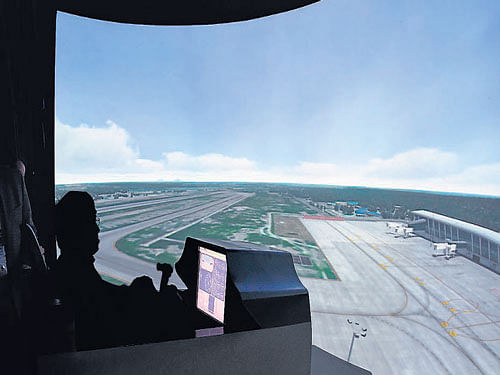
Hyper-graphics with ultra high resolution visuals, digitally stitched together to mimic reality as it is. Project this on a curved canvas, and you are ready with the perfect setting for a helicopter simulator like no other.
This is exactly what the American firm, Rockwell Collins and Indian simulation major, Zen Technologies teamed up to showcase to the Indian armed forces and other visitors at the Aero-India 2015. A firsthand experience by Deccan Herald had the realism take on a distinct Bengaluru tilt.
As the copter cockpit seat tilted in tandem, the simulator screen shifted from a default American terrain to the Kempegowda International Airport (KIA). A decisive turn on the control here and a turn there, and the copter was suddenly flying right over the airport. Vehicles moved photo-realistically on the periphery.
The message was clear: That the graphics on the hi-fidelity screen could be customised in any way. Designed for this was the synergy between Rockwell’s high-contrast projectors and its EPE 8000 computer graphics, and Zen Technologies’ display system and database.
The graphics are completely programmable, explained a Rockwell Collins engineer. “The EP 8000 has 4 gigabytes of texture memory.” The Zen database could incorporate 3D models, satellite imagery and photo-realistic models.
The primary objective of a simulator, as Brig KS Verma, a Zen official explained, “is to replicate reality as closely as possible. This would reduce capital costs of actually flying a helicopter including the fuel costs.”
So, when the cockpit seats moves to enact a full-motion simulation, it actually hits you when there is a hard landing or a sudden tilt.
Combined with the displays, the full system then gives the desired effect. Said Verma: “When you are flying over Bengaluru, you actually feel you are there hovering above the City. The huge developments in mapping have only added to the overall effect.”
All helicopter training in the future are likely to be simulation-based, and simulators could be mandatory requirement. With the Indian armed forces set to acquire 1,000 copters over the next 10 to 15 years, rotor-wing simulation might well be the next big thing.